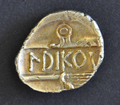NM·13
| Coin | |
|---|---|
Coin type | |
| Coin type: | stater (Lejeune B5, Pautasso "Salassi" f) |
| Description: | obverse: circle, three parallel lines, triangle shape with grid pattern, reverse: circle with dot, trident, legend |
| Material (main component): | gold |
| Average diameter: | 2.25 cm0.886 in <br /> |
| Average thickness: | unknown |
| Average weight: | 6.76 g0.00676 kg <br />0.0149 lb <br /> |
| Workmanship: | chased |
|
| |
| Archaeological culture: | unknown |
| Date: | 2nd c. BC |
| Date derived from: | typology |
|
| |
| Number of known pieces: | 2 |
| Area of circulation: | Valais, Valle d'Aosta |
| Mint / Main site: | unknown |
| Coordinates (approx.): | none |
Coin legend | |
| Idealised transliteration: | prikou |
| Idealised original script: | |
| Position: | back, centre |
| Orientation: | 0° |
| Direction of writing: | dextroverse |
| Script: | North Italic script (Lepontic alphabet) |
| Letter height: | 0.4 cm0.157 in <br /> |
| Number of letters: | 6 |
| Number of words: | 1 |
| Number of lines: | 1 |
| Inscription type: | minting authority |
| Language: | Celtic |
| Meaning: | 'Prikou' (?) |
|
| |
| Alternative sigla: | Whatmough 1933 (PID): 328 |
|
| |
| Sources: | Pautasso 1966: 141 |
Images
Commentary
Two specimens of the coin type are known:
1. Pautasso 1966: tav. CXII.543: Collombey/Roc de la Barme (Valais), 6.67 g, 1.83–2.19 cm; Musée cantonal d’archéologie et d’histoire (Lausanne), inv. no. MMC 357 (examined, photos above): prikou (Inventar der Fundmünzen der Schweiz 12: 27, Abb. 18)
2. Pautasso 1966: tav. CXII.544: Verrès (Aosta) in 1861, 6.85 g; Museo dell’Accademia di Sant’Anselmo (Aosta), no inv. no. (catalogue no. 38).
No. 1 was found in 1852 and published in Blanchet 1853 (see Geiser et al. 2012: 88 on the find place); no. 2 was found in 1861 and first mentioned in Longpérier 1861: 343 f.
Images in Mommsen 1853: Taf. I.1 (drawings of no. 1), Longpérier 1861: tav. XV.1 (drawings based on Mommsen's = Longpérier 1883 III: tav. X.1 = Pautasso 1966: pl. CVII.1 =Geiser et al. 2012: 88, fig. 19), Pauli 1885: Taf. I.6 (drawings based on Mommsen's), De La Tour 1892: pl. XXXVII, XV.2 (drawings based on Longpérier's), Pautasso 1966: tav. CXII.543 (photos of no. 1 = Pautasso 1972b: 41.3) and CXII.544 (photos of no. 2), Orlandoni 1971: 423, no. 38 (photos of no. 2), Wiblé 2000: 236, no. 2 (photos of no. 1), Geiser et al. 2012: 88, fig. 20 (photos of no. 1) and 89, fig. 21 (photos of no. 2).
The coin type belongs with group B of coin legends in the Lepontic alphabet, represented by legends on gold coins with primary distribution in the Aosta region and the Valais, associated originally with the Salassi, today with the Uberi (see Numismatics). The dating follows Inventar der Fundmünzen der Schweiz 12: 28 for gold staters of the Uberi; Whatmough PID: 139 considers the present type to belong neither to the oldest nor to the youngest types in this group (but cf. Geiser et al. 2012: 89). Wiblé 2000: 236, no. 2, dates the coin type to the 2nd–1st c. BC.
The legend, inscribed between the straight horizontal lines of the two design elements on the reverse, is excellently well legible on both specimens, see Mommsen 1853: 202, no. 1; CII: III, no. 4, Longpérier 1861: 344, no. 1, Pauli 1885: 5, no. 6, PID: 136 f., no. 328, Pautasso 1966: 141, Orlandoni 1971: 163, no. 38, Lejeune 1971: 129, no. B5, Marinetti & Prosdocimi 1994: 44 f., Wiblé 2000: 236, Morandi 2004: 511.
Lejeune 1971: 129 assumes that prikou is an abbreviation of a compound personal name (see the word page), but comparison with NM·9 anatikou suggests that -ou is an ending, as two personal names with second element in u̯° abbreviated in exactly the same way would be surprising (thus also Marinetti & Prosdocimi 1994: 44). The spelling ⟨ou⟩ may be evidence for a development of /ū/ to /ou̯/ (dialectally in the west of the Cisalpine Celtic area? cf. AO·3 from Aosta as well as VB·3.2 and VB·3.3 from Ornavasso), or orthographic – either due to influence from Greek writing practice, or a spelling compromise between the vernacular ending -ū and the Latinised ending -ō. Cf. the legend coppou beside coppo on Noric coins (Göbl 1973: 83 f., 117).
Map
Bibliography
| CII | Ariodante Fabretti, Corpus inscriptionum italicarum antiquioris aevi. Ordine geographico digestum et glossarium italicum, in quo omnia vocabula continentur ex umbricis, sabinis, oscis, volscis, etruscis aliisque monumentis quae supersunt, Augusta Taurinorum: 1867. |
|---|---|
| De La Tour 1892 | Henri de la Tour, Atlas des Monnaies Gauloises, Paris: 1892. |




